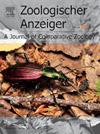The rise of a Titan: a new species of the giant Titanolebias killifishes, and its phylogeny (Cyprinodontiformes: Rivulidae)
IF 1.5
3区 生物学
Q2 ZOOLOGY
引用次数: 0
Abstract
The genus Titanolebias comprises the largest-bodied seasonal killifishes, inhabiting temporary wetlands of the La Plata Basin and adjacent areas in South America. Here, we describe a new species from the Eastern Chacoan region, representing the first record of the genus in this area, providing important biogeographic and evolutionary insights. Phylogenetic analyses confirm the monophyly of Titanolebias, placing Titanolebias monstrosus as the sister species to the remaining species of the genus and recovering the new species as sister to a clade composed of Titanolebias prognathus, Titanolebias elongatus, and Titanolebias cheradophilus. Titanolebias species, exhibits reduced sexual dimorphism, potentially associated with a trophic shift toward larger prey in the origin of this genus and presents several potential cases of aggressive mimicry. Megalebias genus represents a case of convergent evolution towards ichthyophagy with Titanolebias. Morphological analyses reveal that the new species present the diagnostic characters of the genus Titanolebias and can be distinguished by its unique coloration and other morphological traits. Behavioral and ecological data are also provided. Despite its restricted distribution and the vulnerability of ephemeral wetlands to habitat loss, the species is found within a National Park. This discovery provides valuable insights into convergent evolution linked to trophic shifts and contributes to the understanding of the evolution, phylogeny, ecology, and biogeography of Neotropical fishes, offering new avenues for future research and conservation policies for this threatened group of fishes.
泰坦的崛起:巨型泰坦鲨的新种及其系统发育(鲤齿目:鲤科)
Titanolebias属是体型最大的季节性鳉,栖息在南美洲拉普拉塔盆地和邻近地区的临时湿地。在这里,我们描述了一个来自东查科地区的新种,代表了该地区该属的第一个记录,提供了重要的生物地理学和进化见解。系统发育分析证实了Titanolebias的单系性,将Titanolebias monstrosus定位为该属剩余种的姐妹种,并将新种定位为由Titanolebias prognathus, Titanolebias elongatus和Titanolebias cheradophilus组成的分支的姐妹种。Titanolebias物种表现出减少的两性二态性,可能与该属起源时向更大猎物的营养转移有关,并提出了几个潜在的攻击性模仿案例。meggalebias属代表了与Titanolebias趋同进化为食鱼的一个例子。形态学分析表明,该新种具有钛油石属的诊断特征,并可通过其独特的颜色和其他形态学特征加以区分。还提供了行为和生态数据。尽管它的分布有限,而且易受栖息地丧失的短暂湿地的影响,但该物种在国家公园内被发现。这一发现为研究与营养转移相关的趋同进化提供了有价值的见解,有助于理解新热带鱼类的进化、系统发育、生态学和生物地理学,为未来对这一濒危鱼类群体的研究和保护政策提供了新的途径。
本文章由计算机程序翻译,如有差异,请以英文原文为准。
求助全文
约1分钟内获得全文
求助全文
来源期刊

Zoologischer Anzeiger
生物-动物学
CiteScore
2.80
自引率
7.10%
发文量
75
审稿时长
>12 weeks
期刊介绍:
Zoologischer Anzeiger - A Journal of Comparative Zoology is devoted to comparative zoology with a special emphasis on morphology, systematics, biogeography, and evolutionary biology targeting all metazoans, both modern and extinct. We also consider taxonomic submissions addressing a broader systematic and/or evolutionary context. The overall aim of the journal is to contribute to our understanding of the organismic world from an evolutionary perspective.
The journal Zoologischer Anzeiger invites suggestions for special issues. Interested parties may contact one of the editors.
 求助内容:
求助内容: 应助结果提醒方式:
应助结果提醒方式:


